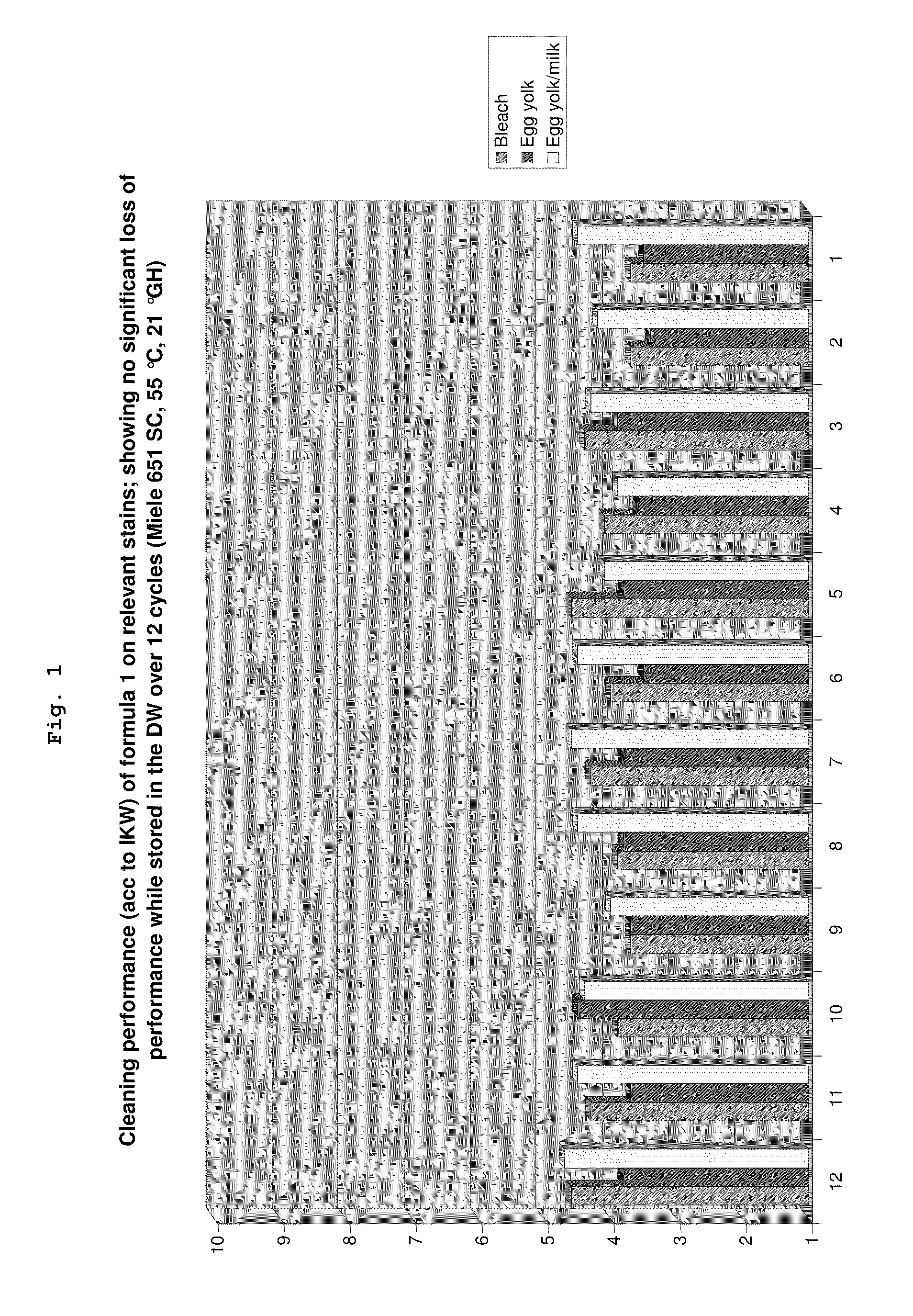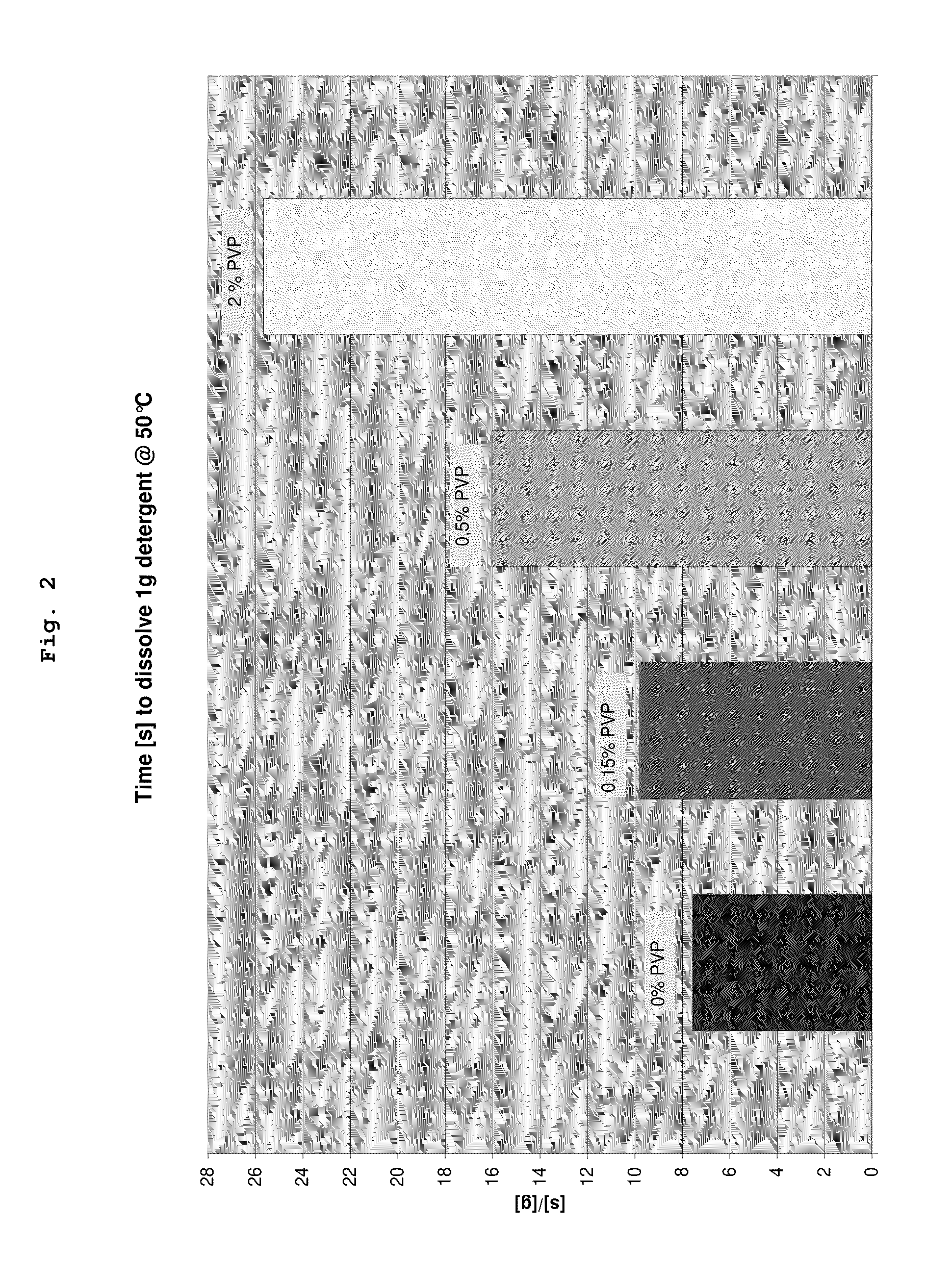Delivery Cartridge
a technology for delivery cartridges and cartridges, applied in the field of delivery cartridges, can solve the problems of inconvenient consumer use, current standards, and unsuitable detergent formulations, and achieve the effects of reducing the number of enzymes
- Summary
- Abstract
- Description
- Claims
- Application Information
AI Technical Summary
Benefits of technology
Problems solved by technology
Method used
Image
Examples
example 1
[0075]Formulae 1 to 7 were prepared using the components shown in Table 1 below. The formulae were added, with stirring in the order given in Table 1, in a Ruberg-mixer 100 for 4 min at 47 rpm to produce a coherent formulation.
[0076]Formulae 1 to 7 were injection moulded under known conditions at the temperatures given in Table 1 using pressures of about 200 bar to produce the detergent sticks. Typically it is possible to use pressures of between about 150 and 1000 bar to produce the sticks.
[0077]Alternatively, the compositions could have been extruded using suitable conditions to produce the detergent stick.
[0078]All amounts in Table 1 are given as the percentage of the stated raw material used to produce the formulae, based on the total weight of the formula.
TABLE 1FormulaFormulaFormulaFormulaFormulaFormulaFormula1234567raw materials% wt% wt% wt% wt% wt% wt% wtPEG 15005.0019.008.0015.8916.005.005.00MGDA disodium salt55.5535.55MGDA disodium salt / PEG 1500 4:1 blend (wt:wt)69.4540.00...
example 2
A Comparison of the Effect of Concentration of GLDA and MGDA on Performance
[0079]The cleaning performance of compositions comprising different levels of MGDA was tested according to the aforementioned IKW test method, using 21° GH and a 50° C. normal dishwashing program in a Miele 651SC automatic dishwashing machine.
[0080]Formulations 8a to 8e were produced comprising various levels of MGDA and having the formulations below in Table 2. A maximum of 60% wt MGDA (based on the total weight of the composition) was used with trisodium citrate replacing MGDA in some formulations so that the overall amount of builder remained constant at 60% wt.
TABLE 2% wtingredient8a8b8c8d8eMGDA60.040.035.030.020.0Tri-sodium citrate0.020.025.030.040.0PEG 150019.019.019.019.019.0Sodium carbonate3.33.33.33.33.3NI surfactant C16-18 / 25 EO2.02.02.02.02.0fatty alcoholNI surfactant C16-18 / 3 EO-PO3.43.43.43.43.4fatty alcohol, low foamingAMPS sulfonated polymer *25.05.05.05.05.0Polyacrylate polymer *35.05.05.05.05...
example 3
A Comparison of Solid Coherent Products with Corresponding Powder Products
[0084]Formulae 1, 2 and 5 of Example 1 were tested in their cleaning performance on tea stains, according to the IKW test method referred to below. Tea stains are normally regarded as stains which require bleaching action. The ranking goes from 1 to 10; the higher the number the better the performance. Water hardness was 21° GH, in a Miele 651 SC Plus dishwasher. The results are shown in Table 4 below.
TABLE 4Formula 1Formula 5Formula 5Powder4.04.44.4Sticks5.45.55.5
[0085]Thus the finding in each case was that the cleaning performance of the sticks was superior to the cleaning performance of the powder, even though the chemical starting composition and the dosage (20 g) is the same, in each case. The conclusion is that the coherent nature of the material offers benefits.
PUM
 Login to View More
Login to View More Abstract
Description
Claims
Application Information
 Login to View More
Login to View More - R&D
- Intellectual Property
- Life Sciences
- Materials
- Tech Scout
- Unparalleled Data Quality
- Higher Quality Content
- 60% Fewer Hallucinations
Browse by: Latest US Patents, China's latest patents, Technical Efficacy Thesaurus, Application Domain, Technology Topic, Popular Technical Reports.
© 2025 PatSnap. All rights reserved.Legal|Privacy policy|Modern Slavery Act Transparency Statement|Sitemap|About US| Contact US: help@patsnap.com


